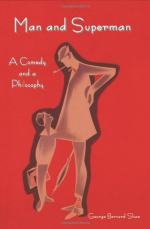|
This section contains 200 words (approx. 1 page at 400 words per page) |

|
Typical of nineteenth-century drama was the "parlor comedy," which had its roots in the "comedy of manners" popularized during the Restoration period (late-seventeenth century). The dominant theme of the comedy of manners was society life, specifically as it related to courtship and marriage. In a comedy of manners, the plot both reflects and satirizes the moral behavior of the characters, who represent "types" of people rather than fully rounded individuals. The parlor comedy moved the action to the parlor, or sitting room, where the characters discussed their predicaments.
Shaw advanced the parlor comedy into the play of ideas. The play of ideas had evolved from Henrik Ibsen's serious parlor dramas, where characters discussed deep moral or social crises. There was more talk than action in Ibsen's work, and Shaw adapted the "talking" play into a dramatized dialogue between conflicting ideas instead of characters. Whereas Ibsen's plays...
|
This section contains 200 words (approx. 1 page at 400 words per page) |

|




